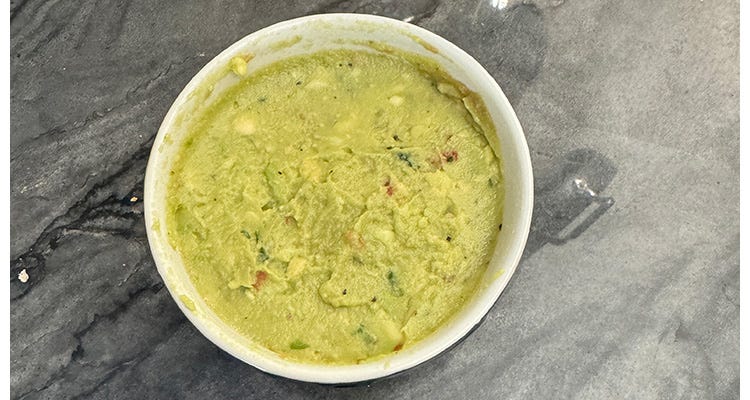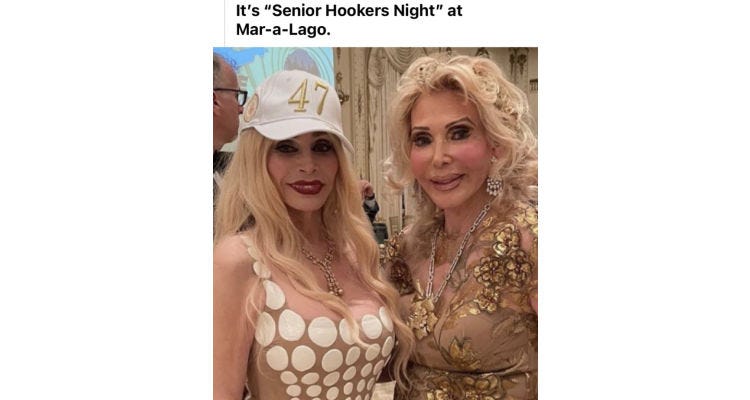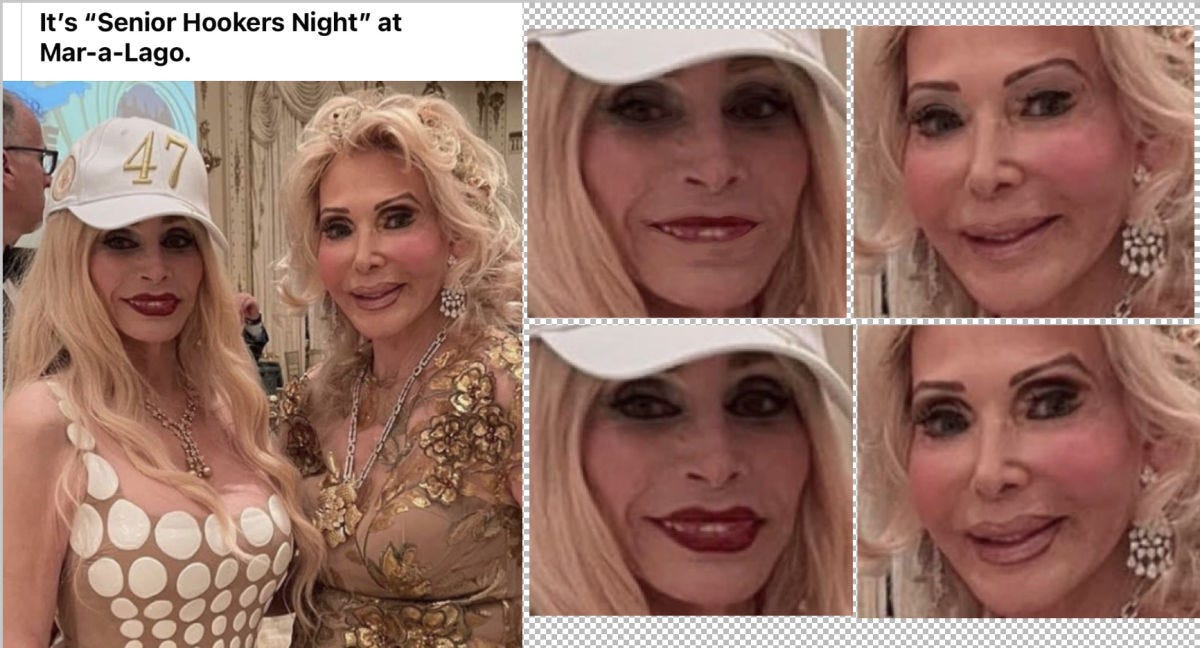What better way to distract from the icy blasts of winter (full disclosure - it’s going to be in the 50’s next week …) than by enjoying some guacamole and chips!
And when you’ve had your fill of chips, and yet some guac remains, what do you do? We all know what oxygen does to avocado, and hence to guacamole. The lovely and appetizing green changes to a dark and bilious hue, one which invites immediate disposal as opposed to energetic dipping.
And I had a brainwave. Since oxygen is the enemy, perhaps we could keep it away. Now I’ve tried plastic wrap in the past and it’s never worked. But perhaps that’s because it wasn’t closely enough married to the surface and thus keep those nasty O2 molecules at bay.
Perhaps where a solid barrier fell short, a liquid one might work? Well, that’s what you’re going to find out. We begin with my green and scrumptious guac:
Upon thinking of an ideal liquid shield, I hit upon olive oil. Delicious in and of itself, a liquid that could cover every nook and cranny, and something that, once at room temp, could be easily poured off. And so - voila:
Now I’m sure some of you will observe that the guac’s top surface wasn’t completely flat. And I decided to leave it that way to see if the oil that coated the higher crags initially would provide protection or not.
The guac prepped, I popped it in the fridge. The next day, I pulled it out and found this:
and I’m not gonna lie - that looks pretty yucky. Clearly any thought of oil coating the top surface and guarding it from the dreaded browning was a big nuh -uh. HOWEVER you can see that there’s some solidified oil in two large areas and maybe those did the trick. Only way to find out was to let it sit at room temp and wait for the oil to liquify. Which I did, yielding the following:
Hmmmm. That looks kind of uniformly terrible, doesn’t it? Time to scrape the top surface. Anything good under there …?
Apparently - yes. And so I scraped off the entire top surface of yucky brownish sludge to uncover what seems to be nice green guac:
What’s the conclusion? Pretty clearly it’d have to be that guac is truly difficult to preserve. I think I’ll have to try an inert gas next …
But speaking of looking nasty, I was recently served an image on FB post that made me stop and think. To start - here’s the post:
Leaving aside the political/sociological undercurrents, what piqued my curiosity wasn’t the gaudy attire but the strange makeup. I was intrigued enough to enlarge and analyze and then to do some reverse engineering.
Before and after pics, after on top of the before. First up, the Miss Megalips. Looking closely I could see where her actual lips ended and pulled off the couple of pounds of extra gloss from her face. As for her eyes, I noted the new-to-me additional line of dark mascara above her eyes and below her eyebrows. Before seeing this I’d never considered accentuating eye sockets. After seeing it I still can’t really get behind it, save as a Halloween effect. Finally, some toning down of the heavy, heavy eyelash action.
The Golden Girl displays that “extra” eyebrow-eyesocket liner even more obviously so clearly I had to remove that as a first step. Some lipstick removal, not as much as in Miss Megalips but still substantial, and finally a strong toning down of the moth-stuck-to-the-eyelids eyelashes and a bit of reshaping the drawn in Dracula eyebrow arch.
The end result, to me (and everyone else who has seen it), is a vast improvement going from the bottom originals to the top.
(Coincidentally, the Wall Street Journal ran this cartoon of mine on last week.)
What I wonder about, though, is the whole “why” of the excessive makeup they actually applied. Evolutionarily, it’s reasonably well accepted that the “point” of makeup is to make women look younger and more mate-worthy. All based on physical traits that show up strongly in the young and fade with age. But I can’t imagine anyone thinking that such an overabundance makes these women appear younger. More likely the opposite. It’s certainly conceivable that some objective observers would approve more strongly of the originals but, as I said, I’ve not found anyone yet who thinks so.
Presuming that this view is the prevailing one, WHY do the girls choose it rather than the easier to apply version I came up with? One that looks, again acknowledging this is subjective, better.
I’m honestly at a loss on this one. Maybe it’s a Florida thing.
And, given that we’e started on a trend of “what stuff looks like”, let’s finish off with an interesting one. One that lets us return to that evergreen source of investigation - the old “why do things look the way they do”?
One of the metrics we read about all the time is resolution. How many pixels do our phones display. How many pixels in the photos? What’s the resolution of that big screen?
One would think that more is alway better but … is it?
Imagine that your eye had only a single receptor - just one. What would you see? Well, what you’d see is a featureless expanse of a single color (presuming your receptor handled color). The world around you that right now you see in all its technicolor glory, filled with billowing clouds in a blue sky and fields of gold studded with green trees would be replaced with one color. Exactly as if you went into an empty room and stared at the wall. At night the color would dim down and in the day it would be brighter. But that’s about it.
If you presume you’re more advanced, say with a nice rectangular array of visual sensory cells arranged in a patter of 246 by 224, then life would look to you like an old Nintendo game, one with terribly primitive graphics. You’d have some idea of what’s going on, but a very coarse one.
You can see where this is going, right? In actuality our eyes have aroundseven million cones and perhaps 150 million rods. The rods are clustered in the center (where we focus our attention) and provide color vision. The must more numerous rods cover the peripheral area and provide black and white sensitivity. Let’s concentrate on the most important focal area cells - the cones. Seven million would translate into a square array of around 6,800 by 6,800. In camera terms, we’re talking seven megapixels.
Whoa, wait. Only seven? Don’t our phones now take 48 megapixel photos? MORE than the total number of cones in our eyes? What does that mean?
It means that after a certain level, increased resolution is literally meaningless. The detail provided is beyond what our eyes can perceive. Our own eyes are the limiting factor. It’s not as bad as just having a single visual sensor but there’s a limit and when you exceed it you’re getting marketing points but that’s about it.
(Note - I know the eye is actually spherical(ish), the rods and cones are distributed, focus doesn’t involve the entire image, etc, etc. But the central point remains so let’s carry on!)
Here’s a little video that demonstrates the effect we just discussed.
What’s happening is the the lines get so sqwooshed together, your eye’s cones get a mix of blue and yellow. And just as in my single cell example, they can only see the average of what’s on offer. In this case - blue plus yellow gets you green! And as a by-the-way, you can also see this effect AND get some cardio by propping your iphone/iPad/computer screen up vertically and then walking away while looking at the image. You’ll see the lines transition into green in the just the same way that they do in the video.
Yes, pictures can be interesting things. As Nicky shows this week.
Nickyitis
Well? Anything to say? Let’s hear it!

















Don’t think there’s much to be done about the oxidizing guac—except to consume every last bit! Congrats on the WSJ cartoon!
I think the senior hookers are going for a Republican-specific look. Blonde hair, heavy but traditional makeup to denote “femininity” like Barbie, Dolly Parton or Vegas showgirls. Most R women in the media look exactly alike- see the Faux News anchor look.
Tressie McMillan Cottom has an excellent essay on the popularity of “Bama rush” Tik-Tok and how it all reinforces traditional white femininity for those threatened by other types of expression.